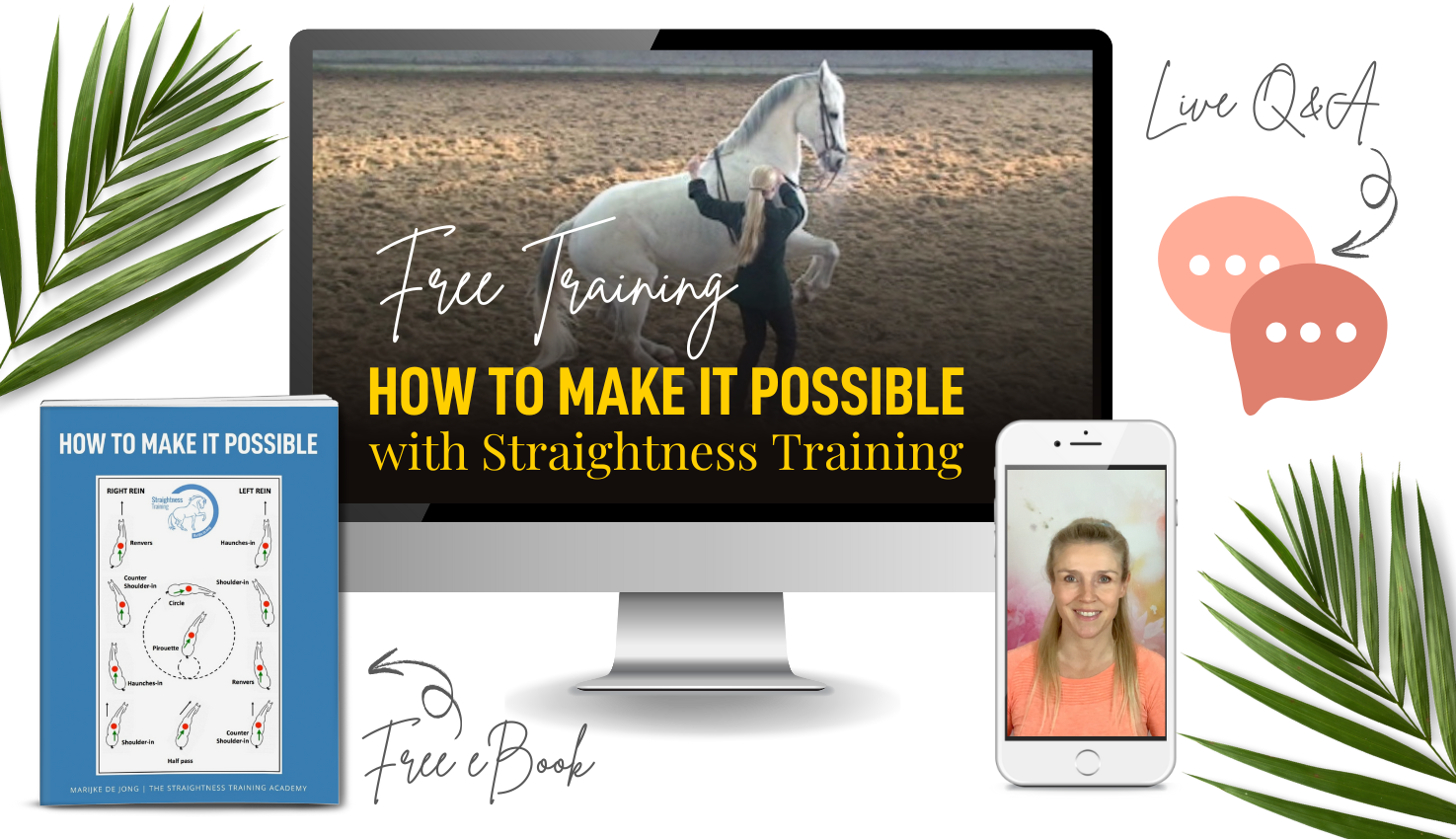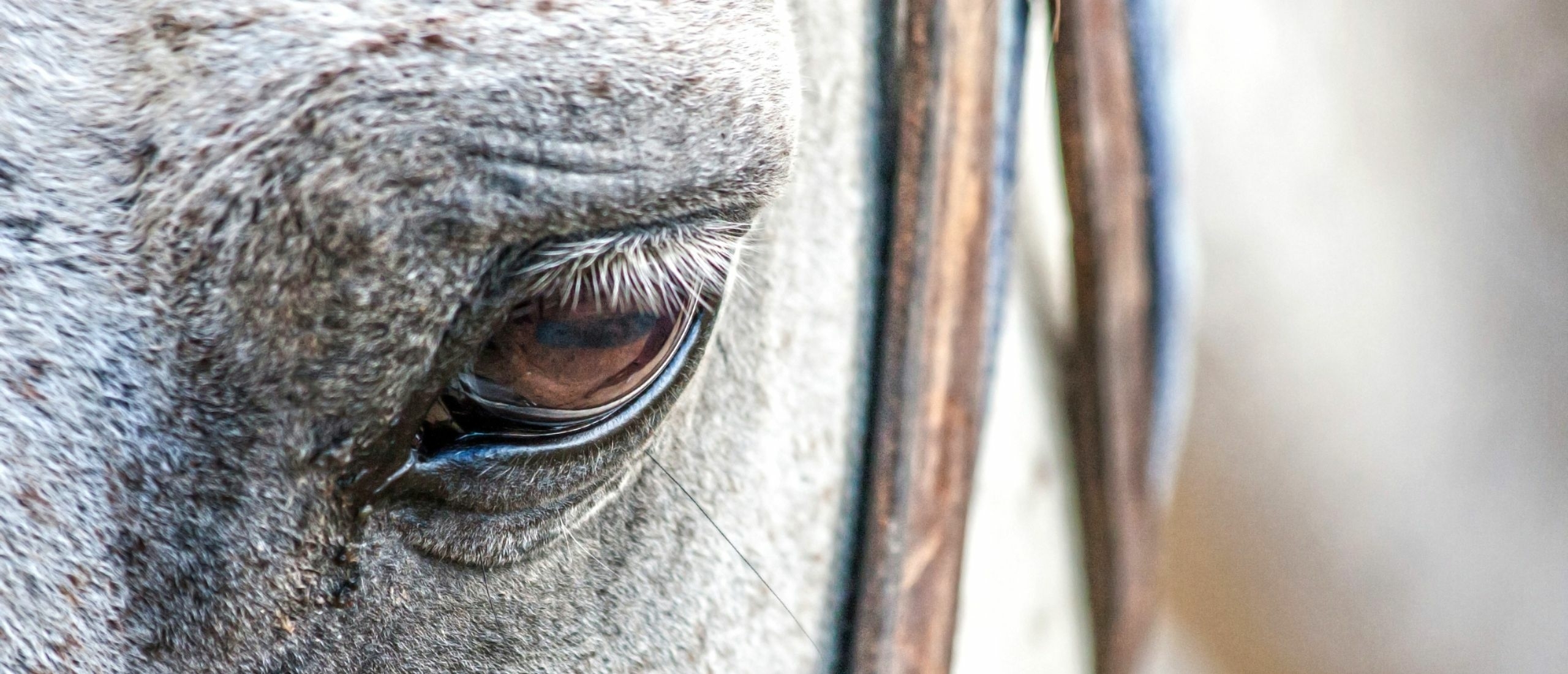
How Horses Learn
To be successful with Straightness Training we have to know how horses learn.
A horse learns in several ways, such as:
- imprinting
- observational learning
- latent learning
- social learning
- habituation
- classical conditioning
- operant conditioning
Below I will discuss these ways of learning briefly.
Imprinting
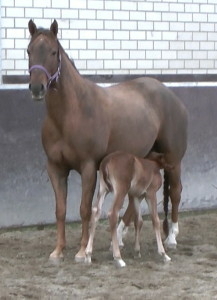 Without any formal training a foal will learn the basics that are necessary to survive. In the first hours of its life, a foal learns the basic instinctual life skills:
Without any formal training a foal will learn the basics that are necessary to survive. In the first hours of its life, a foal learns the basic instinctual life skills:
- who its mother is
- who belongs to the herd and who does not
- what means danger, what is dangerous and what is not
- what the body signals of the other animals mean
- where he can find the milk
In the first 24 hours of life, the hard disk of a foal is ”open” to record all the information needed. That is necessary because horses in the wild are prey animals and a foal should be able to immediately run with the herd after birth.
Observational learning

Also by simply observing the environment, a young horse learns more about recognizing food and danger.
This is also called observational learning.
Latent learning
Later on the foal naturally learns to make connections between different stimuli (stimulus A means no risk, stimulus B means danger, etc.). He learns to familiarize himself with his environment, including blowers, dogs, garbage bins, cars, inside a trailer, a wooden floor, gravel, water, etc.
This is called latent learning. What a horse has already seen as foal under good circumstances and with positive experiences, he will be less scared of as an adult horse.
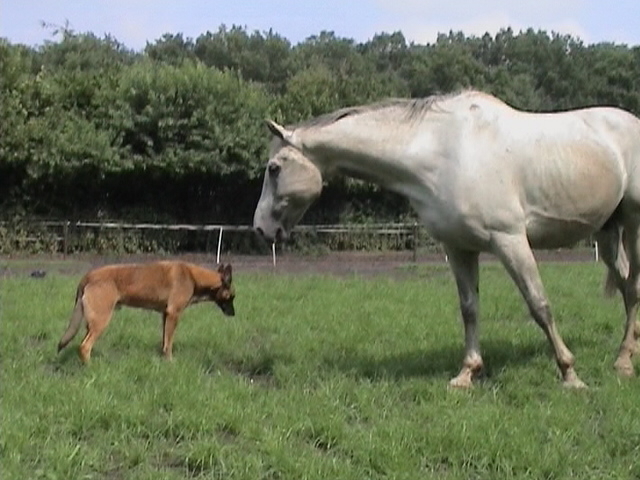
Social learning
The influence of the social environment is crucial for young animals. A young horse must learn from other horses. He must learn the social skills and the right manners. This is also called social learning.
The young horse learns his social skills by deliberately going too far while playing. The adults within the herd will automatically and consistently deal with any unruly behavior.
High speed and quick reactions that are necessary for surviving, the horse can learn the best from his counterparts. A slow response means that there is a possibility that you will not survive. No human can teach them as well and some hrses that have been in close contact with humans during their first three years of life ban be a lot slower in reacting to stimulus.
Isolation of a foal can cause traumatic effects just as it can with children. If a horse grows up in a pasture with only his mother to play with during his first three years, then this horse will not learn social skills as well as a horse that grows up with a herd.
Habituation
By habituation the horse will learn that a stimulus is irrelevant, and learns to reduce and finally lose his flight response. Habituation is a form of learning in which the horse is repeatedly confronted with a stimulus with the intent that his (flight) response to this stimulus will decrease over time.
Here is an example of habituation to an audible and visual stimulus:
- A horse is put in a pasture close to a railway. Several times a day, a long train will pass. The first time it will scare the horse, but the fear behavior will decrease, because the horse will experience that every time the train passes nothing happens. So he learns that no fearful consequences are associated with the trains passing by and over time the horse will not even look up anymore and will continue to graze peacefully.
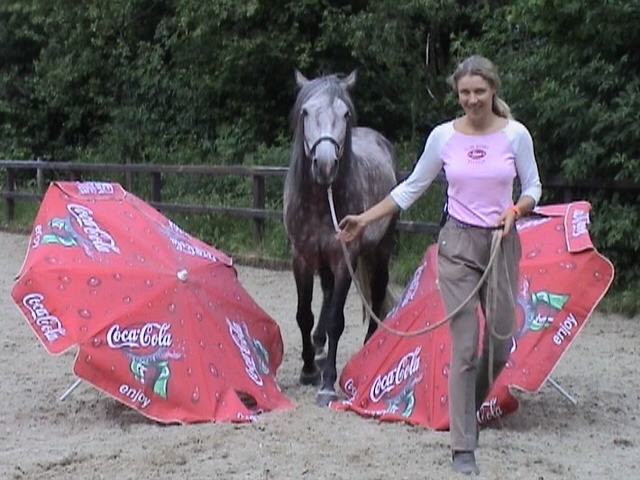 It is important that a horse learns to adapt his behavior to the environment and that he learns to ignore meaningless stimuli. Otherwise he would waste too much energy as he goes through life, because every unnecessary fright caused by a meaningless stimulation requires energy (adrenaline production, heart rate raises, breathing speeds up, etc.).
It is important that a horse learns to adapt his behavior to the environment and that he learns to ignore meaningless stimuli. Otherwise he would waste too much energy as he goes through life, because every unnecessary fright caused by a meaningless stimulation requires energy (adrenaline production, heart rate raises, breathing speeds up, etc.).
Other audible, visual and tactile sensations which a horse can get used to are:
- opening of an umbrella
- fluttering things
- loud banging sounds
- horns and bells
- applause
- a leaf blower
- a lorry, tractor etc.
- water etc.
Once a horse is used to tractors, then perhaps he starts to think that trucks are no longer scary and he categorizes these objects under “non-dangerous”. This is called “generalization“.
Classical conditioning
Another form of learning is ‘conditioning’. Classical conditioning is about learning by association, so it’s a form of associated learning.
In this type of learning the horse realizes and learns that “This means that”.

The Pavlovian Reflex is well known: when the dogs heard the bell ringing, they started drooling as they knew the bell was associated with food.
So therefore you can teach a horse certain voice commands and voice, whip and body cues.
So by classical conditioning the horse makes connections, and creates associations with certain commands and cues and displays specific behavior to those commands and cues.
Examples of conditioning:
- Via classical conditioning you can teach your horse to trot on the longe by saying ‘Trrrrrrrrot’.
- You can teach your horse to do haunches-in towards you on the diagonal by teaching him the whip cue (see picture).
- You can teach a horse that a ‘click’ means a treat. When the horse associates a click with a treat, you can use the click to bridge the gap between the performed behavior and the treat. Bridges can come in all forms: clickers, whistles and voice cues like “X” or ‘YES” or “KOOD” where good is spoken with a hard and short K.
- Most horses are happy to go to the pasture. When you arrive every day in the same car and then take the horse straight out to the pasture, the sound of the car will soon be enough to start the horse whinnying, because he associates the car with something nice.
- If your neighbor always brings your horse a sugar cube, soon the horse will start to whinny and salivate as soon as he hears footsteps of your neighbor on the gravel path of the driveway.
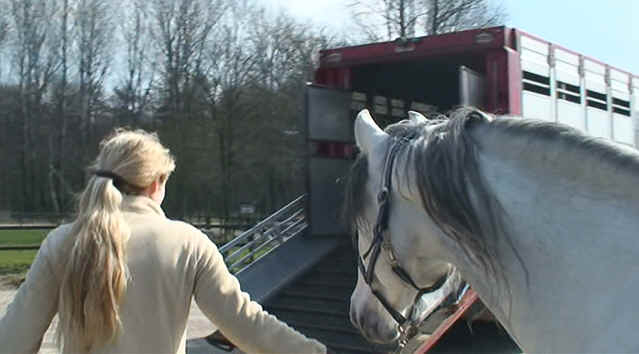
- Horses with a trailer problem often associate the trailer with a negative feeling. This may occur because the horse first experienced the trailer along with pressure and/or pain (whip use, hitting their head against the roof or similar) for example. Just seeing the trailer will later make the horse feel threatened and show related behavior. The horse now associates the trailer with ‘not nice’.
- When a horse meets a rider who always puts pressure on a horse when it doesn’t accept ‘new things’ immediately (like a jump, water, fly spray etc.), the horse might start to approach ALL new things with fear. This is called ‘conditioned fear‘. The horse isn’t fearful from the start, only curious, but if the rider never allows the horse to investigate new things, and views curiosity and the horse’s need for investigation as ‘hesitance’ or even ‘resistance’, then his reaction will be that he starts to put pressure on the horse. And this might lead to ‘conditioned’ fear if the horse starts to associate ALL news things with pressure, and here also a way of learning takes place that is called ‘generalization‘. (In a way this is also close to operant condition, which is about TEACHING behavior, except that the rider isn’t aware that he’s teaching the opposite of what he desires!)
Operant conditioning
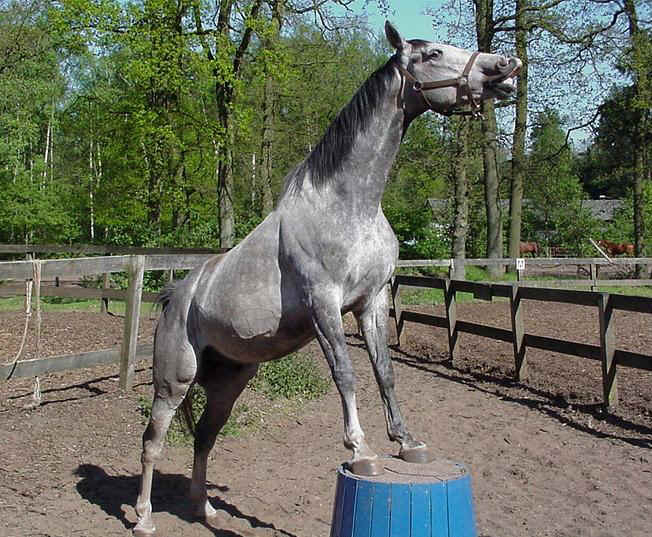 Operant conditioning is about learning by consequence, so it’s a form of ’cause & effect’ learning.
Operant conditioning is about learning by consequence, so it’s a form of ’cause & effect’ learning.
In this type of learning the horse realizes and learns that “When I do this, this happens”.
In this form of conditioning the horse will establish a connection between:
- His own actions (e.g. stepping on a tub with his front feet, or grabbing the reins with his mouth).
- And the consequence/impact of this action (e.g. getting a treat as a reward or a firm “NO” as punishment).
Operant Conditioning works with reinforcement but can also work with correction (punishment).
The word ’’operant’’ means that a certain behavior deviating from the normal behavior repertoire is going to be conditioned.
You can teach a horse that a desired behavior will be encouraged and undesired behavior will be discouraged:
- Desired behavior can be increased by adding a stimulus, by rewarding him. (When the horse lift his leg tell him “good” and give him a treat).
- Desired behavior can be increased by removing the stimulus, with horses that is often the pressure. (You remove the pressure, when the horse follows the rope).
- Undesired behavior can be reduced by adding a stimulus, by punishing him. (An electric shock of the fence prevents the horse breaking out of the pasture).
- Undesired behavior can be reduced by removing the stimulus (This is often used with children; the favorite toy gets taken away when the child is naughty).
From a schematic point of view, operant conditioning comes down to the following:
REINFORCEMENT | PUNISHMENT | ||
Reward/release | Correction | ||
Increase desired behavior | Decrease undesired behavior | ||
+ R Positive reinforcement | -R Negative reinforcement | +P Positive correction | – P Negative correction |
ADD stimulus | REMOVE stimulus | ADD stimulus | REMOVE stimulus |
Treat, “Good boy” | Remove pressure, release | “NO”, tap, kick, electric fence | Remove toy, food, attention |
Extreme dedication to one approach
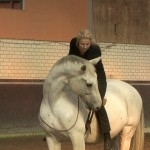 Now some riders are completely against punishment. Some even reject any form of pressure and only wants to work with positive reinforcement, and stick to this approach only.
Now some riders are completely against punishment. Some even reject any form of pressure and only wants to work with positive reinforcement, and stick to this approach only.
On the other hand there are riders who are very much against the use of treats, and mainly rely on the ‘pressure/release’ techniques, i.e. negative reinforcement and positive correction.
Extreme dedication to a single approach ignores the benefits of the other approaches. So in ST we prefer not to only
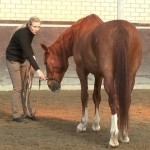
have a hammer in our tool kit, so to speak. Having the flexibility of choosing the appropriate tool (approach) out of our tool chest leads us to tailor made teaching, which is necessary, because every horse is unique.
And some approaches won’t be useful in specific situations, for example once you end up in a very stressful situation. Then treats don’t work anymore, because in a state of fear, food is not interesting for a horse.
Another aspect that riders choose for a certain approach is because of the ‘words’. Words are only symbols to define something, but some riders feel uncomfortable with the use of words such as ‘pressure’ and ‘punishment”. The association we as human have with certain words is based on our past experiences, on our beliefs, and on our perceptions of the world. We have to respect these views, however it seems more of a ‘word choice’ or semantic discussion, than a practical one. You could also replace the word ‘punishment’ for ‘correction’, and ‘pressure’ for ‘signal’ or ‘trigger’; We could still speak about the same approach, only using different words.
And there are interesting phenomena going on when it comes to training horses:
- Almost every rider uses negative reinforcement, even if they don’t want to admit it.
- Some riders call what they do ‘negative reinforcement’ when it’s actually ‘positive correction’.
- Some riders use only positive reinforcement, but in a manipulative way, where the trainer uses an extreme Telling Style and literally ‘tells’ the horse what to do with voice commands, so their horse act like a conditioned soldier or robot. These horses obey very well to all commands, but there’s no real ‘language’ going on. The horse learned a certain limited vocabulary and now obeys to the commands, but these are the only ‘tricks’ he knows. And if it are conditioned ‘dressage tricks’ most of the time these performances lack physical quality because the trainer lost sight of the essence of dressage.
It’s best to avoid extremes and to stay on a continum. In nature things are never static, everything is dynamic. We need to have the dynamic ability to go from +R, to -R, to say ‘no’ (+P) and to take away the treat (-P) , we need to feel free on the entire spectrum so we can choose the approach that suits the situation, the type of behavior and the personality of the horse best. Only then we can achieve the results we are looking for: a straightened and balanced horse in all areas: physical, mental, emotional and spiritual.
Situational Approach
So in ST we prefer ‘situational teaching’, so we can choose the approach that works best for the horse in the given situation at a certain moment in time.
- – R: Considering that a horse is very much used to deal with pressure/release in the wild and while living in a herd with other horses, this technique is very easy to understand for a horse when applied properly (good timing and dosing).
- + R: By using treats or a lot of praise you can get an additional effort of a horse in meeting your request. They can become more eager to perform, because of the extra reward in the form of a treat.
- +P: When a horse ends up in a more pushy state, you could act like ‘electric fence’ and warn the horse by projecting the idea of “I would not touch me if I where you‘. But if he does, it’s in his own interest that he discovers the clear boundaries, and that he is corrected, just like the electric fence would do: totally without emotion, so without any form of anger, fear, or frustration. Like a calm, wise, older mare would do with a tomboy youngster.
- – P: A horse should always see a treat as a gift from you to him, he may never have the idea that he’s taking the treat from you, that puts you in a submissive position. So if he’s too eager in taking the treat, just remove the food, tell him it is yours, and he has to wait, until he is in a more polite and well mannered state.
So in ST we prefer to have all tools in our tool kit, and we choose the strategy that suits the situation, the type of behavior and the personality of the horse best. There is not single right way that suits every horse.
Now in ST almost all training is accomplished through positive and negative reinforcement.
And we hardly need to go in the house of punishment, because we also use ‘repetition‘ as a motivation strategy, because repetition is the mother of all skill. So the better the horse will be in a certain behavior, the more likely that it will increase the frequency that the horse will do this behavior. Repetition creates good and positive habits. So behavior that has been rehearsed is always likely to occur again.
We also use ‘prevention‘ in ST – were we prevent the horse from rehearsing undesired behavior. This is a more powerful strategy than ‘ignoring’ undesired behavior, because when you just ignore the undesired behavior, your horse might keep repeating it, so he will get better at it. It’s also a more powerful strategy than ‘punishment’ because punishment can cause fear or aggression. So better to prevent the undesired behavior from happening or to redirect the behavior.
‘Redirection‘ is also a strategy we use in ST and it gives the horse a choice to gain a reward if he chooses another behavior than the undesired behavior he’s about to start. So it’s about reinforcement of an alternative; It’s about motivating the horse to do another behavior instead of the undesired behavior. And if he does, he will receive a reward.
Every Approach can be Used and Misused
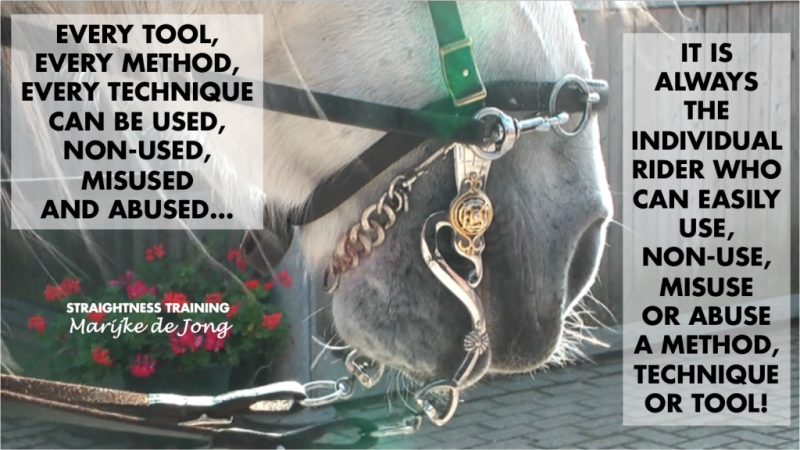 Remember; it’s never the approach, it’s always the human behind the approach.
Remember; it’s never the approach, it’s always the human behind the approach.
Even the ‘best’ approach / strategy / technique / method / concept / tool can lead to a drama when used poorly!
So as we have seen, even positive reinforcement can lead to a complete disaster when used poorly… horses can start to act acting like a soldier or robot, or they might start to beg because of the treats and this might even lead to biting and kicking!
So again: it’s never the approach, it’s always the human behind the approach.
Links To Related Articles
- Avoid Too much, Too long, Too often, Unexpected, Sudden Pressure >>
- It’s Always The Human Behind The Tools >>
- The 7 Mental States Of A Horse >>
- How to Inspire Your Horse >>
- Inspire the Mind, the Body will Follow >>
- How To Motivate Your Horse >>
- Capture What You Get, Not What You Want >>
- A Break Can Do Wonders >>
- What Does The Position Of The Ears Mean? >>
- Self Carriage in Body & Mind >>

